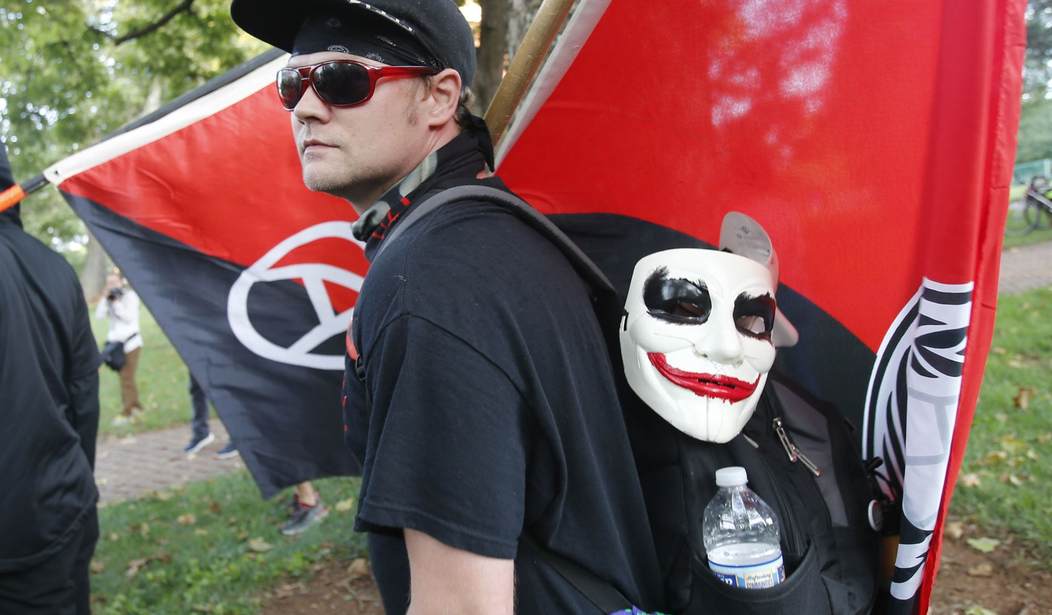Two strangers argue in an online chat room. It starts with taxes and border policy. It ends, as too many arguments do now, with one of them flinging the conversation-ending curse: fascist, Nazi, Hitler. No evidence. No definition. Just the sharp moral dismissal, argumentum ad Hitlerum fired like a flare.
Outside an ICE facility, protesters chant the same words at federal officers doing paperwork and processing detainees. Brownshirts. Fascists. Nazis. The chant rises and falls like a mantra, the ugliness of the label detached from the history behind it.
On social media, accusations multiply. Trump=Nazi, Trump=Hitler, an equivalency made so often it becomes a buzz. The label floats free of its source, emptied of meaning but still carrying all the old venom. One day, a young man, his mind twisted by these words, marinated in online absolutism, convinced he is living through the rise of Hitler 2.0, climbs onto a rooftop near a campaign rally. He fires into the crowd. The presidential candidate is wounded. A husband and father is murdered in front of his wife and daughters.
The nation reels.
The headlines are grim.
And the same people who normalized the language step forward to say the line they always say: “Well, words have consequences.”
They’re right, of course. But not in the way they think.
The Meaning We Lost
Jonah Goldberg's iconic book Liberal Fascism attempted to bring clarity to the word "fascist," defining it as a form of authoritarian statism: a merger of government, industry, and cultural power under a unifying ideology, enforced by hierarchy, coercion, and the promise of national rebirth. He was drawing on the original, historical meaning of the term, the Mussolini model, not the slur. Real fascism meant a single party, a strongman leader, suppression of dissent, the elimination of political pluralism, state-directed economics, and a militarized culture that glorified struggle and obedience.
Unfortunately for Goldberg's argument, today's young progressives mean something completely different by "fascist." They have kept the ugly carapace of a poisonous word but hollowed out its political content and packed it with a new moral meaning, one that serves their purposes better than the historical one. In their usage, “fascist” no longer describes a regime or ideology. Rather, it marks someone as an outsider to their worldview, as someone dangerous, illegitimate, emotionally threatening, or unwilling to affirm the assumptions of their moral tribe.
Understanding this shift is the first step in understanding why modern political language so often feels unmoored, and why arguments about “fascism” today rarely involve history but rather how one thinks and what one believes.
The Classical Meaning of Fascism
Originally fascism described a very specific political system. Mussolini’s Italy is the template.
Fascism meant a political system with:
- a single ruling party
- a strongman leader whose will defined the state
- suppression of dissent and opposition
- control or coordination of industry through the state
- a hierarchy that demanded obedience
- a culture organized around discipline, struggle, and national unity
It was anti-liberal, anti-democratic, and openly hostile to individual rights. The citizen existed to serve the state, not the other way around. The word fascism comes from the Latin fasces, a bundle of rods lashed around an axe, carried by Roman lictors to symbolize authority and unity. Ironically, the United States borrowed this symbol long before Mussolini did; fasces appear in the House of Representatives, on the old Mercury dime, and in other official iconography. The imagery reflected a republican idea: many rods bound together are stronger than one. But the American meaning and the totalitarian meaning share only a symbol, not a philosophy.
Nazism added an even darker layer:
- racial-biological ideology
- antisemitism as a core doctrine
- eugenics
- the belief that the nation could be “purified” through extermination
In other words, both systems were concrete, structured, and recognizable. They had doctrines, institutions, and methods. The meaning was not metaphorical, emotional, or just another way of saying "people with whom I disagree."
But then a remarkable case of intentional linguistic drift — the migration of the meaning of a word — was initiated as part of the Cold War. Of course it was the Soviets.
How the Meaning Began to Drift
The first major break with the classical definition came almost immediately after World War II. The Soviet Union discovered that “fascist” was too useful a weapon to leave tied to its original meaning. So they broadened it.
In Soviet propaganda, fascist no longer referred only to Mussolini or Hitler. It now meant:
- anti-communist
- pro-capitalist
- pro-Western
- supportive of democratic institutions
- or simply resistant to Soviet influence
The label became a political bludgeon, not a description. And because communist parties, student movements, and intellectual circles in the West echoed Soviet rhetoric, that expanded meaning began circulating far beyond the Iron Curtain. This was the first fracture: “fascist” shifted from naming a specific system to condemning an opponent.
The word was still political, but no longer precise. It was already on its way to becoming something else entirely.
The Student-Movement Expansion
By the 1960s, the term had drifted even further. Campus radicals in the United States and Europe adopted “fascist” as their default label for any authority they opposed.
Police were fascists. University administrators were fascists. Parents enforcing rules were fascists. Professors maintaining standards were fascists.
The word no longer described a political system. It described power they disliked.
This is where “fascist” began shedding ideological content altogether. It became a catch-all term for repression, conformity, or simply disagreement with the revolutionary mood of the time. It no longer mattered whether the target had anything in common with Mussolini’s Italy. What mattered was emotional resonance: the person is an obstacle to my will, therefore they are fascist.
At this point, the word had ceased to operate as historical language. It had become a protest word,shorthand for rebellion, not analysis.
The meaning continued to migrate throughout the 70s through 90s. Punk culture especially adopted it, and even mainstream conversation began using it as a shorthand for any restrictive or controlling behavior.
A strict teacher was a fascist. A demanding boss was a fascist. A bureaucrat enforcing rules was a fascist. Even a fussy hall monitor could be called a fascist.
This is a very long way from Mussolini's Brownshirts, and in less than fifty years.. It no longer implied a political ideology, a government structure, or a philosophy of the state. It simply expressed disapproval: “I don’t like how much control you have over me.” By the end of the century, “fascist” was almost entirely unmoored. It had become a vague cultural insult, a way to portray someone as harsh or overbearing without engaging in any real description.
And then, in the digital era, the word’s meaning morphed once again, this time into something even further removed from its historical anchor. Worse, it became more than just an insult or perjorative. It became dangerous.
The Identity-Politics Shift
With the rise of identity politics and online activism in the early 2000s and accelerating into the 2010s, “fascist” stopped meaning authoritarian and started meaning harmful, specifically harmful to a protected identity group.
The perverse syllogism runs like this:
- Disagreement is harm.
- Harm is violence.
- Violence is oppression.
- Oppression is fascism.
And with this simple A=B logic — for it is logic, though the foundation is built on air — disagreement, harm, violence, oppression, and fascism all become the same thing. Disagreement=fascism.
In this framework, the content of the disagreement doesn’t matter as much as the emotional effect. If your words make someone feel unsafe or invalidated, your position is classified as fascist, regardless of whether it has anything to do with nationalism, hierarchy, or state power.
This is also where “Nazi” reenters the vocabulary, not as Hitler’s ideology, but as a symbolic category of ultimate moral evil. Calling someone a Nazi no longer means they advocate genocide. It simply marks them as beyond the bounds of the moral community, a figure whose presence is considered dangerous because it disrupts the emotional safety of others.
The relationship becomes almost mathematical:
fascist : Nazi = bad : worse.
And of course, to be Hitler is to be the very worst of all.
At this stage, the terms are no longer political at all. They are hardly even words in the sense that words carry semantic meaning. They are emotional containers and moral labels, used to enforce group cohesion and to designate outsiders.
What the Words Mean Now — and to Whom
Different groups now use “fascist” and “Nazi” to mean entirely different things.
To conservatives and the historically literate
The words retain their old meanings: Mussolini’s statism, Hitler’s racial ideology, the machinery of oppression and coercion. The accusations sound absurd when applied to political opponents who share none of those traits.
To young progressives
The words describe:
- emotional danger
- ideological dissent
- refusal to affirm identity-based norms
- resistance to their moral worldview
“Fascist” marks someone as harmful. “Nazi” marks someone as morally illegitimate. And "Hitler" means you are the devil.
None of these has any connection to 20th-century regimes, and the young progressive is unlikely to recognize any real historical content even if you present it.
The irony
Because young progressives apply these labels in the service of moral purity and ideological enforcement, their behavior begins to resemble the early stages of actual fascist movements:
- policing conformity
- punishing dissent
- treating opponents as existential threats
- collapsing disagreement into “harm”
- stripping opponents of legitimacy
- justifying aggression as moral duty
The resemblance is psychological rather than ideological, but it is unmistakable.
The confused middle
Most people, those who really hold no ideology but are that persuadable center that both Republicans and Democrats seek to sway, hear the same word from two sources and don’t know what is being asserted. The accusation feels serious, but the intended meaning is often trivial or purely emotional.
This confusion is not accidental. It is the result of decades of semantic drift. The original meanings of “fascist” and “Nazi” hardly appear in everyday conversation, but the progressive usage does, loudly and often. As a result, the meaning that dominates public understanding is the new one, the one detached from history but still carrying all its poisonous emotional weight.
Why the New Meaning Is So Dangerous
What makes this drift hazardous is that the new meaning lives inside the old shell. The historical resonance remains poisonous. So when someone uses the word in its new sense — “you make me feel unsafe” — the old charge still fires in the public imagination.
This produces a volatile mixture:
- trivial triggers
- that are attached to apocalyptic labels
- which imply moral mandates
- on which some people act literally
Most of the time it results in social-media mobs and professional destruction. But in the worst cases, it escalates to real-world violence, including, at its extreme, assassination.
Until we reclaim the meaning of the word, or stop pretending the same word means the same thing to everyone, the danger will only grow.
Editor’s Note: Help us continue to bring fresh ideas and cultural commentary to your browser. Join PJ Media VIP and use promo code FIGHT to get 60% off your membership.









Join the conversation as a VIP Member